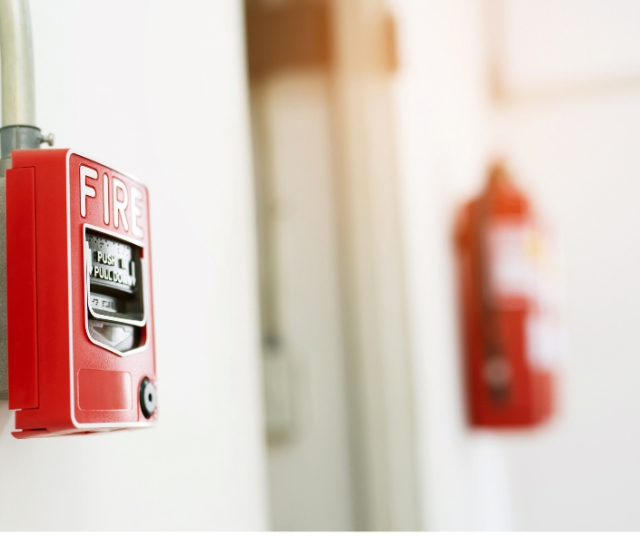Home fires can occur at any time and have devastating consequences. How quickly you act can make the difference between a minor incident and a tragedy.
Fire Prevention at Home
Installation and Maintenance of Smoke Detectors:
The first line of defense against home fires are smoke detectors. Make sure you have detectors installed on every level of your home and inside every bedroom. Test the detectors regularly and change the batteries at least once a year.
Fire Extinguishers:
Purchase fire extinguishers suitable for your home and place them in strategic places, such as the kitchen, garage and hallways. Learn to use them correctly and check their pressure regularly to ensure their effectiveness.
Wiring and Plug Inspection:
Faulty wiring is a common cause of fires. Regularly inspect your home's wiring for signs of wear, and replace damaged wires or plugs immediately.
Safe Use of Electrical Equipment:
Unplug appliances when not in use and avoid overloading outlets. Never use extension cords permanently, and make sure your equipment meets safety standards.
Care in the Kitchen:
The kitchen is a common source of home fires. Never leave food on the stove unattended, and be sure to clean any grease residue from appliances. Keep cloths and utensils away from heat sources.
Safe Storage of Flammable Products:
Store flammable products, such as cleaning fluids and gasoline, in safe, well-ventilated areas, away from heat sources. Be sure to follow the manufacturer's recommendations for proper storage.
What to Do in Case of Fire at Home
Keep calm:
In the event of a fire, staying calm is crucial. Panic can make it difficult to make effective decisions. Take a deep breath and assess the situation.
Quick and Safe Evacuation:
If the fire is large or cannot be easily controlled, evacuate the building immediately. Having a previously established evacuation plan can make all the difference.
Call the Emergency Service:
Before trying to put out the fire, call emergency services so professionals are on the way. Provides detailed information about the location and severity of the fire.
Proper Use of the Fire Extinguisher:
If you decide to try to put out the fire with a fire extinguisher, remember to use the PASS technique: aim the fire extinguisher at the base of the fire, pull the trigger, move the fire extinguisher from side to side, and step back while continuing to spray.
Avoid Smoke:
In a fire, smoke can be as dangerous as the flames. Stay close to the ground, where the air is cleanest, and use a damp cloth to filter the air you breathe.
Closing Doors and Windows:
When evacuating or attempting to control a fire, close doors and windows behind you to help contain the fire. This can slow its spread and provide more time for evacuation.
Use Fire Blankets:
Fire blankets are useful for putting out small fires. Keep one on hand in risk-prone areas, such as the kitchen or workshop. Place the blanket over the fire to cut off its oxygen supply.
Never Use Water on an Oil Fire:
If the fire involves cooking oil or other flammable liquids, do not try to put it out with water. Water can cause an explosion. Use a Class K fire extinguisher designed specifically for these types of fires.
Avoid Entering Rooms with Heavy Smoke:
If you encounter a hot door during evacuation, do not open it. If there is heavy smoke, avoid entering as there may be fire on the other side. Look for alternative evacuation routes.
Meet at a Safe Meeting Point:
After evacuating, meet in a safe place outside the building to make sure everyone is safe and to make it easier to account for people.
After the Fire: Steps to Follow
Damage Inspection:
After firefighters have put out the fire, wait until it is safe to return before inspecting the damage. The structure of the building could have been weakened.
Contact your Insurance Company:
Report the incident to your insurance company as soon as possible. Provide accurate details and photographs, if possible, to facilitate the claim process.
Repairs and Restoration:
Coordinate repairs and restoration with qualified professionals. Some damage may not be immediately visible, so a thorough evaluation is essential.
Emergency Plan Review:
After a fire, review and update your emergency plan based on experience. Learn from the situation to improve future preparation.
Emotional Support:
House fires can be traumatic. Seek emotional support for yourself and your family, whether through friends, family, or mental health professionals.
Investing in smoke detectors, fire extinguishers, and creating an evacuation plan can make all the difference in protecting your home and your loved ones. Remember that speed and calm are essential in emergency situations. By following these guidelines, you can significantly increase your chances of successfully overcoming a house fire and minimizing damage.
